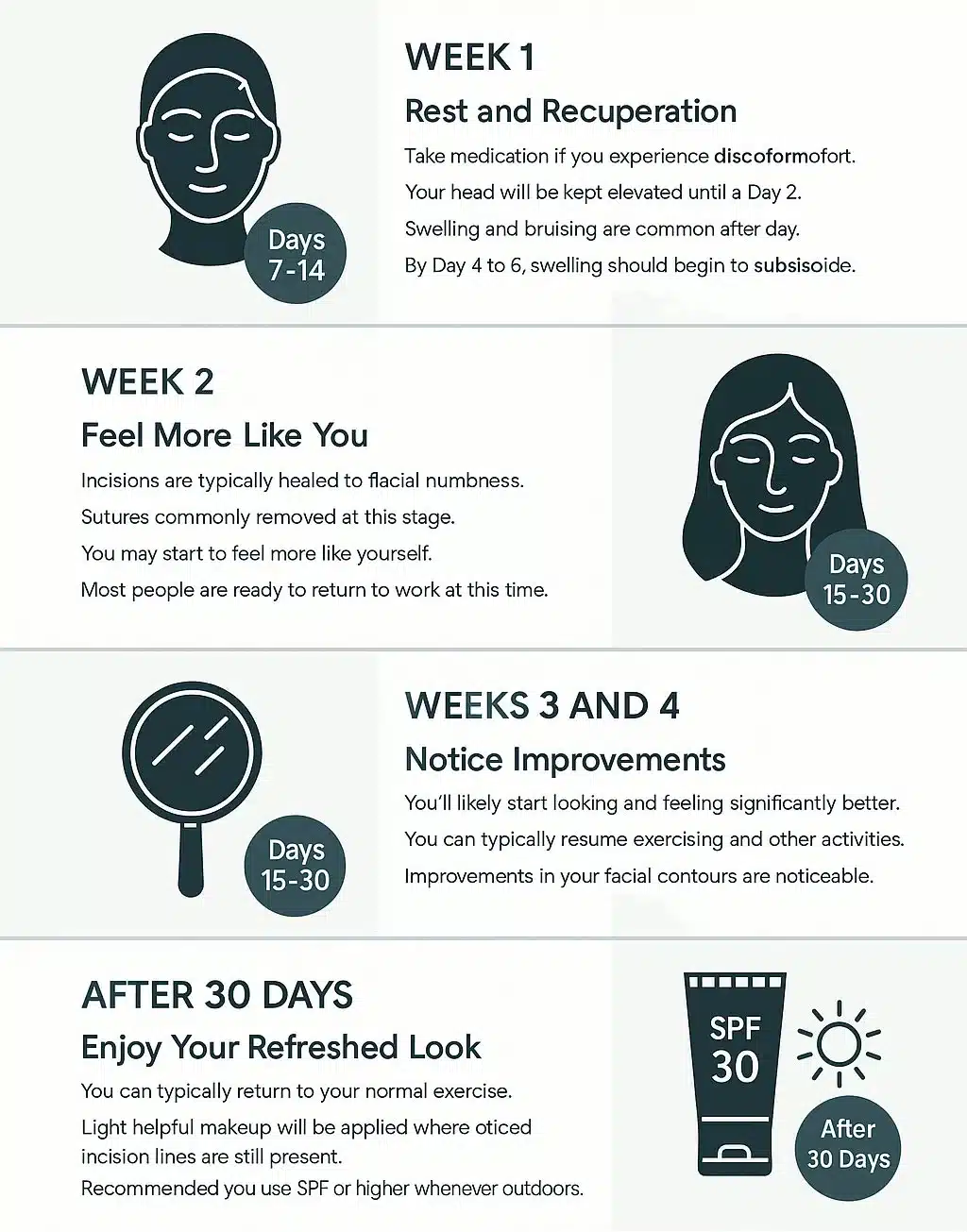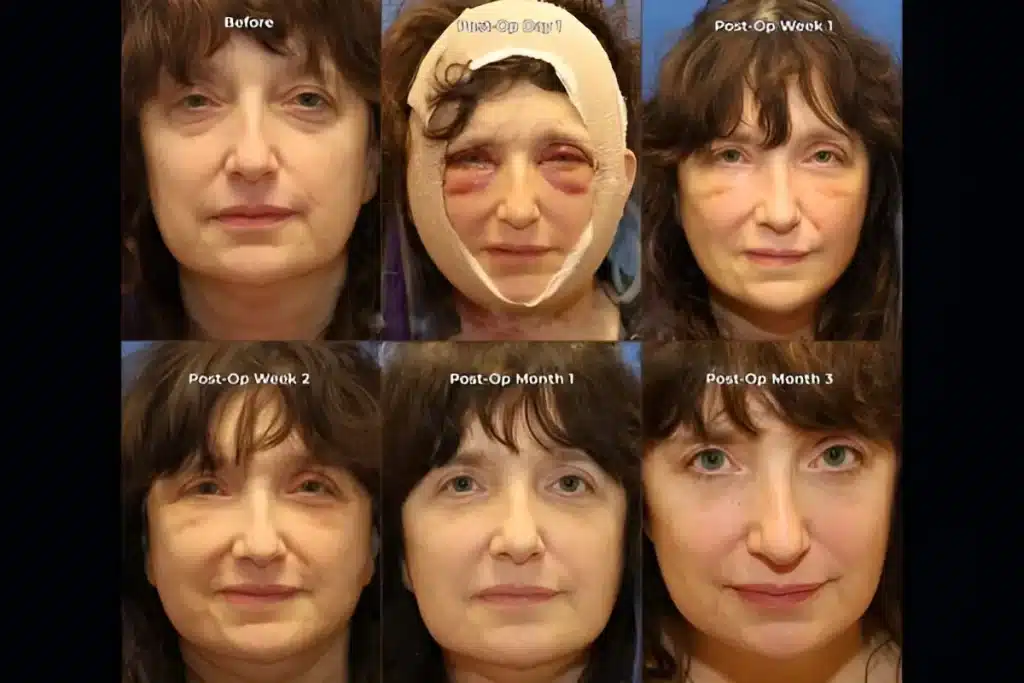How long is the rhytidectomy recovery time? Most patients recover within 2 to 4 weeks for daily activities and see final results between 3 to 6 months. The first few days include swelling, bruising, and rest.
By week two, visible improvements begin, and full healing continues gradually. Every case is unique, but proper care and follow-up support a smoother, safer recovery.
Dr. Joel Kopelman, a board-certified facial plastic surgeon with over 35 years of experience, leads Kopelman Aesthetic Surgery in New York. Patients trust Dr. Kopelman for natural-looking results and highly personalized care.
This guide explains every stage of the facelift recovery timeline. You’ll find practical tips, expert insights, and clear answers to common questions about rhytidectomy recovery time. Whether you’re considering a facelift or preparing for surgery, this article will help you feel confident and informed at every step.
Table of Contents
ToggleFacelift Recovery Timeline

Day 1–3: Immediate Post-Op Facelift Effects
In the first 72 hours, patients experience swelling and bruising around the face and neck. Minor discomfort is common and managed with prescribed pain medication. Dr. Kopelman advises keeping the head elevated and avoiding any bending or lifting.
This period is critical for stabilizing incision sites and beginning the healing process. Patients should also avoid unnecessary movement the day after surgery to promote healing.
A Week After Surgery 1: Swelling, Bruising, and Rest
During the first week, swelling and bruising remain visible but gradually improve. Most patients continue resting with limited movement. Post operative care includes cleaning incision sites and following daily care instructions. Stitches or staples may be removed between days 5 and 7, depending on your healing progress.
Facelift Swelling Timeline: What’s Normal?
Some swelling may last for several weeks. Minor swelling around the jawline and cheeks is expected. It usually peaks around day 2 or 3 and decreases slowly. Cold compresses and keeping your head elevated help reduce inflammation. Persistent or painful swelling should be reported to your surgeon.
Weeks 2–4: Lower Facelift Recovery Progress
By week 2, many patients begin light activities. Bruising fades, and swelling improves significantly. If you’ve had a mini facelift in NYC, healing may be slightly faster due to the less invasive nature of the procedure. Lower facelift recovery focuses on tissue settling and scar healing.
You can return to work if your job doesn’t involve strenuous activities. Makeup may be used to conceal mild discoloration.
1 Month and Beyond: Final Facelift After Surgery Results
At four weeks, most patients feel socially confident. The face and neck continue refining their shape. Incision lines fade over time. Full recovery times vary, but many see final results between 3 and 6 months post surgery.
A neck lift done alongside the facelift may take slightly longer to heal fully. This phase marks a key stage in the post facelift recovery process.
How Long Does It Take to Look Normal After a Facelift?
Most patients appear presentable after 2–4 weeks. Swelling and tightness reduce steadily. By the 1-month mark, improvements are noticeable but subtle. Full natural appearance may take several months depending on skin type and the facelift procedure performed.
Pain, Healing, and Expectations
How Painful Is a Full Facelift?
Pain is usually mild to moderate and well-controlled with medication. Most discomfort occurs within the first few days. Tingling or numbness in facial skin may persist temporarily. Dr. Kopelman ensures each patient receives a tailored post op facelift pain management plan.
Common Side Effects During Face Lift Healing Time
Swelling, bruising, and tightness are common. Numbness near incision sites may last a few weeks. Minor asymmetry can occur as tissues settle.
Most effects resolve with proper care and time. Always follow the care instructions provided to minimize risk.
What’s Normal vs. When to Call Your Surgeon
Mild discomfort, swelling, and bruising are expected. Call your plastic surgeon if you notice increasing redness, pus, or fever. Sudden pain or bleeding may signal complications. Regular check-ins with your provider help ensure a safe recovery process.
Post-Op Care and Restrictions
Post Op Facelift Tips for Home Recovery
Use cold compresses and sleep with your head elevated. Avoid smoking and alcohol. Follow all post surgery care instructions closely.
After a few days, you should engage in gentle walking to improve circulation. Keep incision sites clean and dry.
What Should You Not Do After a Facelift?
Avoid heavy lifting, bending, or high-impact movement. Skip makeup until incisions close. Don’t expose your face to direct sun or heat.
Refrain from facial massages or spa treatments. Let your skin and tissue heal naturally.
How to Speed Up Facelift Recovery Safely
Stay hydrated and eat nutrient-rich foods. Avoid processed snacks and alcohol. Use recommended skincare products. Stick to your surgeon’s care plan.
Patients who rest properly and follow instructions tend to recover faster with fewer complications.
For those undergoing cosmetic procedures, understanding the recovery process is essential for long-term success.
Safety, Risks, and Surgeon Follow-Up
Is a Facelift a Major Surgery?
Yes. A facelift is a surgical procedure that requires anesthesia, incisions, and recovery time. It involves lifting and repositioning tissue in the face and neck. While considered safe in expert hands, it still carries risks like bleeding, infection, or poor healing.
While facelifts are often associated with older adults, facelifts for younger patients are growing in popularity due to early signs of aging or genetic factors.
Signs of Infection or Complication
Watch for symptoms like warmth around incisions, unusual discharge, or worsening swelling. These may indicate infection. Contact your surgeon if you notice any of these. Early intervention prevents further issues.
When to Contact Your Surgeon
Call your provider if you experience strong pain, uneven swelling, or bleeding. Don’t wait for symptoms to worsen. Kopelman Aesthetic Surgery provides all patients with detailed follow-up schedules to support safe recovery.
Long-Term Outlook
How Long Does a Facelift Last?
A facelift typically lasts 7 to 10 years. Factors like age, lifestyle, and skin quality all play a role in the longevity of your results. With proper skincare, sun protection, and a healthy routine, many patients maintain a refreshed and youthful look for years. Although the natural aging process continues, the improvements from your facelift procedure remain visible.
Some individuals choose periodic non-surgical cosmetic procedures—such as fillers or laser treatments—to maintain their results. These options can complement the effects of your facelift and extend its benefits. Dr. Kopelman provides guidance on maintaining your outcome through each stage of the recovery process.
Some patients wonder how many facelifts you can have over a lifetime. Dr. Kopelman can help determine whether additional procedures may be beneficial down the line.
When Can You Resume Daily Activities
Light activities, such as short walks or desk work, can usually resume around two weeks post-surgery. Most patients feel ready to return to work within 10 to 14 days, depending on their healing progress and job demands. Avoid strenuous activities, intense workouts, or travel for 4 to 6 weeks to protect incision sites and minimize swelling and bruising.
Recovery times differ for each person. Following care instructions and listening to your surgeon helps you return safely to your normal routine. During follow-up appointments, Dr. Kopelman will assess your healing and give you clear, personalized recommendations.
Schedule a Consultation
Dr. Kopelman and his team at Kopelman Aesthetic Surgery specialize in delivering lasting, natural-looking results. With decades of experience in facial plastic surgery, he helps patients understand every step—from the day after surgery to the final results. If you’re planning a facelift or want expert advice on post-facelift recovery, now is the time to act.
Schedule your consultation with Dr. Kopelman today to receive a personalized assessment, learn about your rhytidectomy recovery time, and explore how long your facelift recovery time may take based on your goals and lifestyle.

























